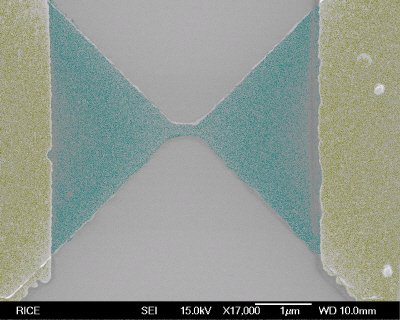
Electrons in magnetic wires just one atom thick behave very differently than those in bulk magnets. So say researchers in Spain, who have observed the ‘Kondo effect’ in tiny wires made of iron, nickel or cobalt — a phenomenon that does not occur in larger samples of these materials.
The effect — which arises from electron–electron interactions not present in pure bulk materials — must be considered when developing future technologies based on nanoscale magnetic structures, says the researchers.
In the first half of the 20th century, physicists were surprised to find that the electrical resistance of extremely cold samples of some metals increased rapidly with falling temperature — the opposite of what is observed at higher temperatures.
Screened impurities
This was explained in 1964 by the Japanese physicist Jun Kondo who showed that at low temperatures conduction electrons in a metal such as gold could become “stuck” to magnetic impurities (such as iron) present in the metal. This curtails the electron’s ability to conduct current and screens the magnetic moment of the impurity.
More recently, physicists have discovered that a similar effect can occur in tiny bits of semiconductor called quantum dots, where an electron spin trapped at the dot takes the place of the magnetic impurity. Now Carlos Untiedt and colleagues at the University of Alicante have seen the effect in atomic-scale ‘wires’ for the first time.
The wires were created using two different techniques. One involved stretching a metal contact with a scanning tunnelling microscope until it is one atom thick, while the other used electromigration to reduce the thickness of a metal contact to just one atom. Different wires were made from iron, nickel and cobalt — all ferromagnetic materials in which the spins of some of the electrons are responsible for magnetism.
Telltale signs
The team then measured the conductance of the wires as a function of temperature and applied voltage. They saw features at zero voltage called “Fano–Kondo” resonances, which are telltale signs of the Kondo effect.
They were surprised to find this effect because there are no impurities or trapped spins in the wire. Instead they believe that interactions between electrons in two different energy states – the localized magnetic “d” electrons and the conducting non-magnetic “sp” electrons – results in the Kondo-like screening of atoms in the wire. The team believes that the interation is enhanced in the wire — as compared to the bulk — because of the lack of neighbouring atoms.
“Our finding shows that, at the nanoscale, electron–electron interactions, which we often neglect, can be extremely important,” said Untiedt.
Big impact on magnetism
The finding means that scientists modelling magnetic properties of nanostructures will need to take these comparatively strong interactions into account, he adds. “The atomic-scale details of magnetic surfaces can have a big impact on how magnetism works at these scales.
The work was published in Nature.



